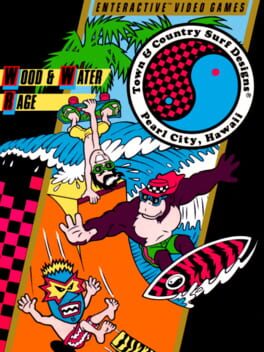Advertising games are a common practice in the medium and have been since its inception. The Famicom already had one such title with Donald Land (1988), a month earlier, but it never left Japan. In February 1988, Town & Country Surf Designs: Wood & Water Rage was released to promote the eponymous surf equipment company. Surprisingly, the game not only features surfing, but also skateboarding, probably to compensate for the extreme inadequacy of the former.
The player assumes the role of one of Town & Country's mascots in two different modes. Skate Street is a horizontal auto-scroller, where the skateboarding protagonist must avoid various obstacles and collect coins to score the most points, while attempting some tricks. Although it is possible to progress numerically through the rounds, the player soon realises that there is only one stage available, which expands as they progress through the rounds, until it reaches its completed form. The obstacles are always all the same and there is no subtlety in their placement. The title nevertheless manages to prove its dearth through its execrable gameplay. The B button is used to accelerate and the A button to jump. In the latter case, the skateboard remains on the ground. To perform an ollie and go over obstacles, it is necessary to press A and the left button at the same time. This wouldn't be a problem, if the collisions in the game weren't so poor. Indeed, it is not uncommon to be hit by a projectile, visually far from the character. In fact, this is because the collision masks have no notion of perspective, as opposed to the player's gaze: this makes for a detestable experience, despite the brevity of the stage. This mode has a few other subtleties, but they are generally negligible: timing is never an issue and the life system is useless at best. Only those who want to do some scoring will have to agonise more over the rough hitboxes.
Big Wave Encounter, the surf mode, is incomprehensible. Movement is erratic and keeping a decent trajectory is a big enough challenge to even attempt tricks. The wave immediately catches up with the player who would like to try them and the core of this mode is to survive until the shore is reached. No interesting ideas emerge from the gameplay, which boils down to sadistic confusion more than anything else. Perhaps because the surfing game was so botched, LJN felt compelled to add a skateboarding mode, functional for lack of substance. Town & Country Surf Designs: Wood & Water Rage represents the void that makes up most advergames. Not surprisingly, its sequel, Town & Country Surf Designs II: Thrilla's Surfari (1992), chose to include only the skateboarding gameplay – there are some surfing sequences, but they are formally identical.
The player assumes the role of one of Town & Country's mascots in two different modes. Skate Street is a horizontal auto-scroller, where the skateboarding protagonist must avoid various obstacles and collect coins to score the most points, while attempting some tricks. Although it is possible to progress numerically through the rounds, the player soon realises that there is only one stage available, which expands as they progress through the rounds, until it reaches its completed form. The obstacles are always all the same and there is no subtlety in their placement. The title nevertheless manages to prove its dearth through its execrable gameplay. The B button is used to accelerate and the A button to jump. In the latter case, the skateboard remains on the ground. To perform an ollie and go over obstacles, it is necessary to press A and the left button at the same time. This wouldn't be a problem, if the collisions in the game weren't so poor. Indeed, it is not uncommon to be hit by a projectile, visually far from the character. In fact, this is because the collision masks have no notion of perspective, as opposed to the player's gaze: this makes for a detestable experience, despite the brevity of the stage. This mode has a few other subtleties, but they are generally negligible: timing is never an issue and the life system is useless at best. Only those who want to do some scoring will have to agonise more over the rough hitboxes.
Big Wave Encounter, the surf mode, is incomprehensible. Movement is erratic and keeping a decent trajectory is a big enough challenge to even attempt tricks. The wave immediately catches up with the player who would like to try them and the core of this mode is to survive until the shore is reached. No interesting ideas emerge from the gameplay, which boils down to sadistic confusion more than anything else. Perhaps because the surfing game was so botched, LJN felt compelled to add a skateboarding mode, functional for lack of substance. Town & Country Surf Designs: Wood & Water Rage represents the void that makes up most advergames. Not surprisingly, its sequel, Town & Country Surf Designs II: Thrilla's Surfari (1992), chose to include only the skateboarding gameplay – there are some surfing sequences, but they are formally identical.
